
Elsham Hall is a 17th-century English country house situated in its own parkland in Elsham, North Lincolnshire. The park and gardens are open to the public. [1]

Elsham Hall is a 17th-century English country house situated in its own parkland in Elsham, North Lincolnshire. The park and gardens are open to the public. [1]
The present house dates back to the 1760s, on the site of an earlier dwelling of which little is known. It is of brick construction, limestone ashlar on the main aspect and rendered elsewhere, and with a Westmoreland slate roof. The house was extended for the then owner, T G Corbett, in the 19th century, although most of the 19th-century service wing was demolished in the 20th. There were further enhancements by the Elwes family in 1933. The house is a Grade II* listed building. [2] [3]
The house includes a Catholic chapel dating from 1933, and an 18th-century stone staircase. [4]
Separate from the house, on its own alignment, is a fine 19th-century orangery, which is a grade II listed building in its own right. [5] [4]
The house is not open to the public.


The origins of Elsham Hall date from the 17th century or even earlier [2] but in about 1760 major additions were made to the building. At this time the property was owned by William Thompson and his wife Elizabeth (née Gore). He died in 1764 and his son Robert Thompson inherited the estate, so it is possible that it was he who made the additions. He died in 1788 and as he had no children he left the house to his niece Elizabeth Corbett. [6] She was the daughter of Humphrey Edwin and Mary Thompson. She was born in 1739 and in 1755 married Thomas Corbett (1730–1808), of Darnhall Hall in Cheshire. When she inherited Elsham Hall, she brought the property to the Corbett family.
From 1800 to 1814 the house was occupied by Jane Gardiner, who ran a girls' boarding school there. [7]
When Thomas Corbett died, their eldest son inherited the estate and also took the additional name of Thompson, becoming William Thompson Corbett (1759–1832). In 1794 he had married Jane Eleanor Ainslie, the daughter of General George Ainslie. They had twelve children; their eldest son, Thomas George Corbett, inherited the property. [8] He married in 1837 Lady Mary Noel Beauclerk, daughter of the 8th Duke of St Albans and his wife Maria nee Nelthorpe. They had one daughter, Eleanor Blanche Mary Corbett, and she married in 1858 Sir John Dugdale Astley, 3rd Baronet. [9] She inherited Elsham Hall in 1868 and so brought the house to the Astley family. Their eldest son also took the additional name of Corbett and so became Sir Francis Edmund George Astley-Corbett, 4th Baronet. He inherited the property on the death of his father in 1894.
In 1925 Sir Francis sold the Elsham estate to King's College, Cambridge as an investment. [10] They sold the house in 1931 to the Elwes family, who still own the property. Captain Jeremy Elwes inherited the property from his Uncle Geoffrey Elwes after the Second World War and restored it with his wife Clare Elwes after occupation as the Antiaircraft HQ. It was then passed to Robert and Gervase Elwes, who have turned it into a very successful tourism and wedding venue. Their two families have restored and developed the venue for future generations as a historic gardens open to visitors under the guidance of the Historic Houses Association. See below.
When Captain Jeremy Elwes died in 1999, his sons Gervase and Robert Elwes inherited the main farms and estate in his 2002 Will Trust, but a separated 1989 Elwes Trust took on Elsham Hall and its gardens. There were also a number of museums and arts charities founded by Capt Elwes, including the Lincolnshire Life Museum, various working windmills, including Wrawby Post Mill, and the St Hugh's Foundation that assists artists to travel overseas in Lincoln. Robert Elwes continued on the Yorkshire Tourist Board, Lincolnshire Tourism, Yorkshire Museums Council. Historic Houses Association, and various arts and tourism committees, winning several national awards. Gervase Elwes is a full-time portrait painter following in the tradition of Sir Simon Elwes, who painted HM the Queen. They have two brothers, Hugh Elwes (banker) and Giles Elwes (TV producer), who live and work in the South of England. Elsham Estate is approximately 1000 hectares of mainly woodland and pasture land with a famous Lambing Sunday. It has a barn theatre restaurant built by Robert Elwes in 1989 that hosts classical music, mediaeval banquets and weddings. Elsham Hall Gardens are open to visitors (see Elsham Hall website) with a carp lake, adventure playground and children's animal farm, and fantasy walled garden.

The gardens include a large medieval carp lake, and a 19th-century coach house and stables, which is a Grade II listed building. [11]
The park and gardens were opened as a country park in 1970 by Captain and Mrs. Elwes "to promote enjoyment of the countryside and wildlife and an appreciation of the arts and rural crafts". [12] [13]
It is a local point of interest and a destination for school field trips, particularly during the spring lambing season. A list of facilities include: [13] [1]
The centre is a registered venue for civil weddings. [14]

Belton House is a Grade I listed country house in the parish of Belton near Grantham in Lincolnshire, England, built between 1685 and 1687 by Sir John Brownlow, 3rd Baronet. It is surrounded by formal gardens and a series of avenues leading to follies within a larger wooded park. Belton has been described as a compilation of all that is finest of Carolean architecture, said to be the only truly vernacular style of architecture that England had produced since the Tudor period. It is considered to be a complete example of a typical English country house; the claim has even been made that Belton's principal façade was the inspiration for the modern British motorway signs which give directions to stately homes.
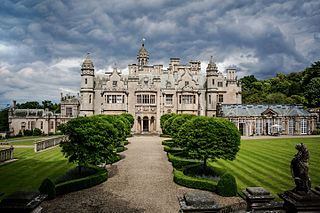
Harlaxton Manor is a Victorian country house in Harlaxton, Lincolnshire, England. It was built for Gregory Gregory, a local squire and businessman. Gregory employed two of the leading architects of Victorian England, Anthony Salvin and William Burn and consulted a third, Edward Blore, during its construction. Its architecture, which combines elements of Jacobean and Elizabethan styles with Baroque decoration, makes it unique among England's Jacobethan houses. Harlaxton is a Grade I listed building on the National Heritage List for England, and many other structures on the estate are also listed. The surrounding park and gardens are listed Grade II* on the Register of Historic Parks and Gardens. It is now the British campus of the University of Evansville.

Buckminster is a village and civil parish within the Melton district of Leicestershire, England, which includes the two villages of Buckminster and Sewstern. The total population of the civil parish was 335 at the 2021 census. It is on the B676 road, 10 miles east of Melton Mowbray and 4 miles west of the A1 at Colsterworth.
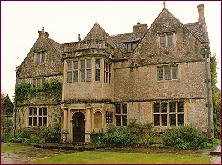
St Catherine's Court is a manor house in a secluded valley north of Bath, Somerset, England. It is a Grade I listed property. The gardens are Grade II* listed on the Register of Historic Parks and Gardens of special historic interest in England.
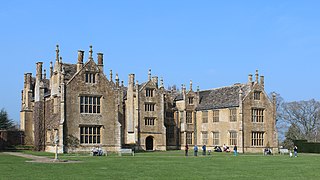
Barrington Court is a Tudor manor house begun around 1538 and completed in the late 1550s, with a vernacular stable court (1675), situated in Barrington, near Ilminster, Somerset, England.

Doddington Hall is, from the outside, an Elizabethan prodigy house or mansion complete with walled courtyards and a gabled gatehouse. Inside it was largely updated in the 1760s. It is located in the village of Doddington, to the west of the city of Lincoln in Lincolnshire, England.
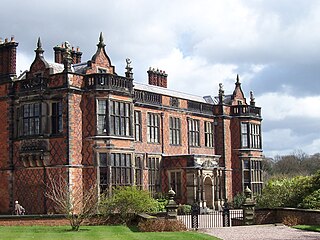
Arley Hall is a country house in the village of Arley, Cheshire, England, about 4 miles (6 km) south of Lymm and 5 miles (8 km) north of Northwich. It is home to the owner, Viscount Ashbrook, and his family. The house is a Grade II* listed building, as is its adjacent chapel. Formal gardens to the southwest of the hall are also listed as Grade II* on the National Register of Historic Parks and Gardens. In the grounds are more listed buildings, a cruck barn being listed as Grade I, and the other buildings as Grade II.

Well is a small estate village and civil parish about 1.5 miles (2.4 km) south of the town of Alford, in the East Lindsey district of Lincolnshire, England. The population of the civil parish was 166 at the 2011 census. It is situated on the foot of the east entry to the Lincolnshire Wolds. The population of 166 as at the 2011 census includes the hamlet of Claxby St. Andrew. The village provides views of the gradually sloping hills towards the west.

Hodsock Priory is an English country house in Hodsock, Nottinghamshire, 4 miles (6.4 km) north of Worksop, England, and 1 mile (1.6 km) south of Blyth. Despite its name, it is not and never has been a priory. Hodsock is renowned for its snowdrops in early spring. It is also a venue for special events and weddings.

Leighton Hall is an estate located to the east of Welshpool in the historic county of Montgomeryshire, now Powys, in Wales. Leighton Hall is a listed grade I property. It is located on the opposite side of the valley of the river Severn to Powis Castle. The Leighton Hall Estate is particularly notable for the hall which was decorated and furnished by the Craces to designs by Pugin in his Houses of Parliament style, for the Home Farm, a model farm, which was to be in the forefront of the Victorian industrialised High Farming, and for the gardens which have their own Grade I listing on the Cadw/ICOMOS Register of Parks and Gardens of Special Historic Interest in Wales. Leighton Hall was also the birthplace of the much disparaged hybrid Cupressocyparis leylandii hedge tree. The hall is in private ownership and is not accessible to the public, although it can still be viewed from the road. The home farm is currently under restoration.

Stoke Rochford Hall is a large house built in scenic grounds, with a nearby golf course, next to the A1 in south Lincolnshire, England.
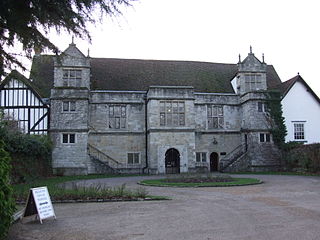
The Archbishop's Palace is a Grade I listed historic 14th-century and 16th-century building on the east bank of the River Medway in Maidstone, Kent. Originally a home from home for travelling archbishops from Canterbury, the building is today principally used as a venue for wedding services. The former tithe barn for the palace, now serves as the Tyrwhitt-Drake Museum of Carriages.
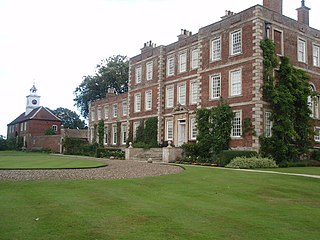
Gunby Hall is a country house in Gunby, near Spilsby, in Lincolnshire, England, reached by a half mile long private drive. The Estate comprises the 42-room Gunby Hall, listed Grade I, a clocktower, listed Grade II* and a carriage house and stable block which are listed Grade II. In 1944 the trustees of the Gunby Hall Estate, Lady Montgomery-Massingberd, Major Norman Leith-Hay-Clarke and Field Marshal Sir Archibald Montgomery-Massingberd, gave the house to the National Trust together with its contents and some 1,500 acres of land.
Billing Hall was a manor house in Billing, Northamptonshire, England. Records of the manor, the predecessor to Great Billing Hall, date back to the 12th century. It was originally owned by the Barry family and Baron Dundalk built it in 1629. It became the county seat of the Earls of Thomond, descendants of Brian Boru, King of Ireland in 1002. With the arrival of the Elwes family in 1779 the history of Great Billing became inextricably linked to them. Perhaps the Hall's most famous resident was Gervase Elwes, the English tenor, who died in a rail accident in Boston, USA in 1921.

Wotton House is a hotel, wedding venue, conference centre and former country house in Wotton near Dorking, Surrey, England. Originally the centre of the Wotton Estate and the seat of the Evelyn family, it was the birthplace in 1620 of diarist and landscape gardener John Evelyn, who built the first Italian garden in England there.

Maunsel House in the English county of Somerset was built in the late 14th or early 15th century. The house stands south of the hamlet of North Newton, in the parish of North Petherton. It is the family seat of the Slade baronets and is a Grade II* listed building.
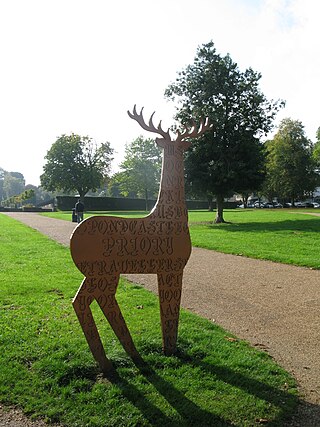
Priory Park is a public park located in Dudley, West Midlands, England, just north of the town centre. It is in the historic grounds of Dudley Priory.

Thomas George Corbett was an English Member of Parliament, and High Sheriff of Lincolnshire in 1840.
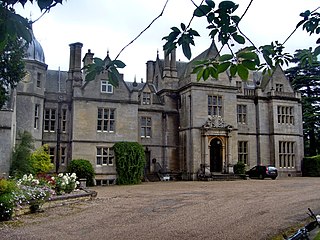
South Rauceby Hall, South Rauceby, Lincolnshire, England is a country house dating from the mid-19th century. It was designed by William Burn in 1842 for Anthony Peacock Willson. Inherited by the Cracroft-Amcotts family, it remains a private home. It is a Grade II listed building.

Well Hall is a country house within the civil parish and estate village of Well, Lincolnshire, England. The house itself is Grade II* listed on the National Heritage List for England, and its park and gardens are Grade II listed. The red-brick house dates from the early 17th century, but was altered in about 1730 for James Bateman, and extended in the late 18th century for Francis Dashwood. It was partly destroyed a fire in 1845, and rebuilt in 1925 by Guy Elwes.